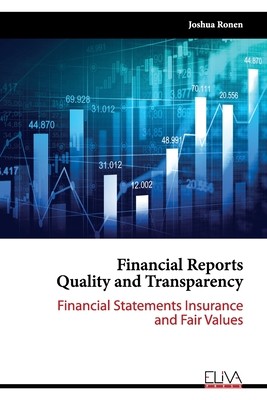
- We will send in 10–14 business days.
- Author: Joshua Ronen
- Publisher: Eliva Press
- ISBN-10: 9975154042
- ISBN-13: 9789975154048
- Format: 15.2 x 22.9 x 1.1 cm, softcover
- Language: English
- SAVE -10% with code: EXTRA
Reviews
Description
The recent pandemic has ravished many aspects of our economy, and it may be years until we emerge with a new equilibrium, one which will likely be marked by a high degree of economic volatility and uncertainty. While a clouded future is bad enough for macroeconomic forecasters, it is just as, if not more troubling for managers of firms who need to glimpse the future to make informed business decisions. For this latter group, it is equally imperative to forecast events and for transactions to be folded into estimates that largely populate financial reports. Many, if not most items in financial statements embed estimates that are subject to measurement error or bias, the latter induced by misalignment of incentives. This potentially deleterious consequence of biased estimates has become even more critical in light of the trend of expanding requirements (over the last two decades or so) by the FASB to incorporate forecasts and estimates in the financial statements. Fair values (discussed in the last two papers in this volume) and the allowance for loan losses are examples. Sadly, the pandemic and its aftermath, because of the heightened uncertainty, is likely to amplify the problem: both measurement error and bias would proliferate, the first because of the enhanced fogginess of the future and the second because managers would be afforded the chance to ascribe more biased estimates to the unreliability of forecasts.
The five articles in this book are relevant to our contemporary conditions. These works address two not entirely unrelated social arrangements (auditing and accounting standard-setting) that have contributed to opacity and misleading information in financial reports. About the Author:Joshua Ronen is a Professor of Accounting at the Stern School of Business, New York University. His primary research areas include capital markets, disclosure, earning management, economic impact of accounting rules and regulations, financial reporting, legal liability of firms, transfer pricing, agency theory, corporate governance, and fair valuation. Professor Ronen's scheme for financial statements insurance has gained wide publicity. His Op-Ed page article in the New York Times was favorably commented on in the Wall Street Journal and introduced at the Senate Banking Committee.
EXTRA 10 % discount with code: EXTRA
The promotion ends in 19d.21:59:26
The discount code is valid when purchasing from 10 €. Discounts do not stack.
- Author: Joshua Ronen
- Publisher: Eliva Press
- ISBN-10: 9975154042
- ISBN-13: 9789975154048
- Format: 15.2 x 22.9 x 1.1 cm, softcover
- Language: English English
The recent pandemic has ravished many aspects of our economy, and it may be years until we emerge with a new equilibrium, one which will likely be marked by a high degree of economic volatility and uncertainty. While a clouded future is bad enough for macroeconomic forecasters, it is just as, if not more troubling for managers of firms who need to glimpse the future to make informed business decisions. For this latter group, it is equally imperative to forecast events and for transactions to be folded into estimates that largely populate financial reports. Many, if not most items in financial statements embed estimates that are subject to measurement error or bias, the latter induced by misalignment of incentives. This potentially deleterious consequence of biased estimates has become even more critical in light of the trend of expanding requirements (over the last two decades or so) by the FASB to incorporate forecasts and estimates in the financial statements. Fair values (discussed in the last two papers in this volume) and the allowance for loan losses are examples. Sadly, the pandemic and its aftermath, because of the heightened uncertainty, is likely to amplify the problem: both measurement error and bias would proliferate, the first because of the enhanced fogginess of the future and the second because managers would be afforded the chance to ascribe more biased estimates to the unreliability of forecasts.
The five articles in this book are relevant to our contemporary conditions. These works address two not entirely unrelated social arrangements (auditing and accounting standard-setting) that have contributed to opacity and misleading information in financial reports. About the Author:Joshua Ronen is a Professor of Accounting at the Stern School of Business, New York University. His primary research areas include capital markets, disclosure, earning management, economic impact of accounting rules and regulations, financial reporting, legal liability of firms, transfer pricing, agency theory, corporate governance, and fair valuation. Professor Ronen's scheme for financial statements insurance has gained wide publicity. His Op-Ed page article in the New York Times was favorably commented on in the Wall Street Journal and introduced at the Senate Banking Committee.


Reviews